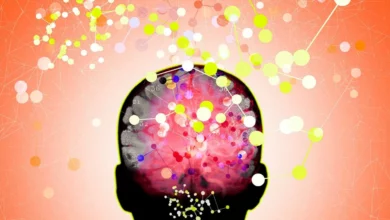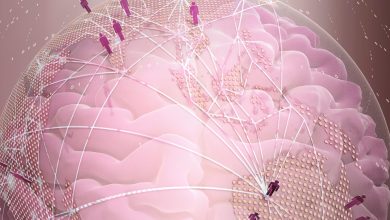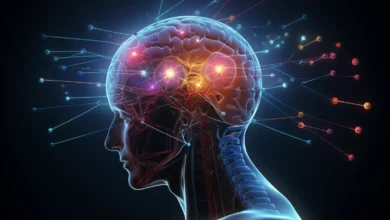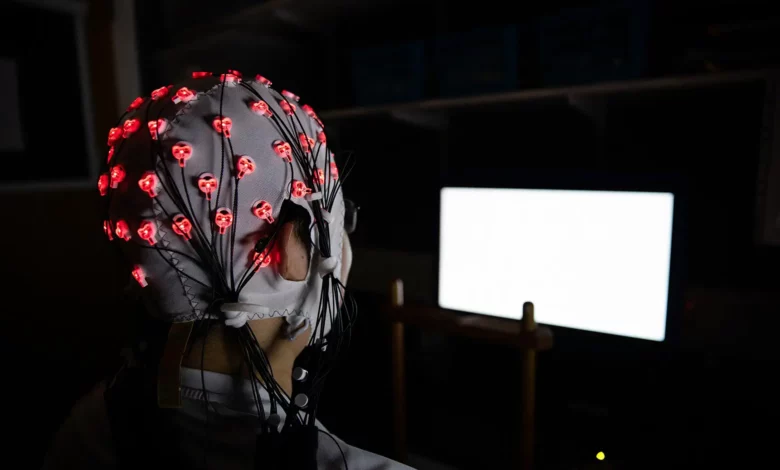
The brainwaves experiment set up in the Adaptive Brain Lab, led by Prof Zoe Kourtzi, in the University of Cambridge’s Department of Psychology. Credit: University of Cambridge
- First study to show that delivering information at the natural tempo of our neural pulses accelerates our ability to learn.
- Participants who received a simple 1.5-second visual cue at their personal brainwave frequency were at least three times faster when it came to improving at a cognitive task.
- When participants were tested again the next day, those who had improved faster were still just as good – the learning stuck.
- Priming brains for optimal rhythms could help us remain quick learners throughout life, help people with learning difficulties, and give professionals an edge in training simulations, according to neuroscientists.
Scientists have shown for the first time that briefly tuning into a person’s individual brainwave cycle before they perform a learning task dramatically boosts the speed at which cognitive skills improve.
Calibrating rates of information delivery to match the natural tempo of our brains increases our capacity to absorb and adapt to new information, according to the team behind the study.
University of Cambridge researchers say that these techniques could help us retain “neuroplasticity” much later in life and advance lifelong learning.
“Each brain has its own natural rhythm, generated by the oscillation of neurons working together,” said Prof Zoe Kourtzi, senior author of the study from Cambridge’s Department of Psychology. “We simulated these fluctuations so the brain is in tune with itself – and in the best state to flourish.”
“Our brain’s plasticity is the ability to restructure and learn new things, continually building on previous patterns of neuronal interactions. By harnessing brainwave rhythms, it may be possible to enhance flexible learning across the lifespan, from infancy to older adulthood,” Kourtzi said.
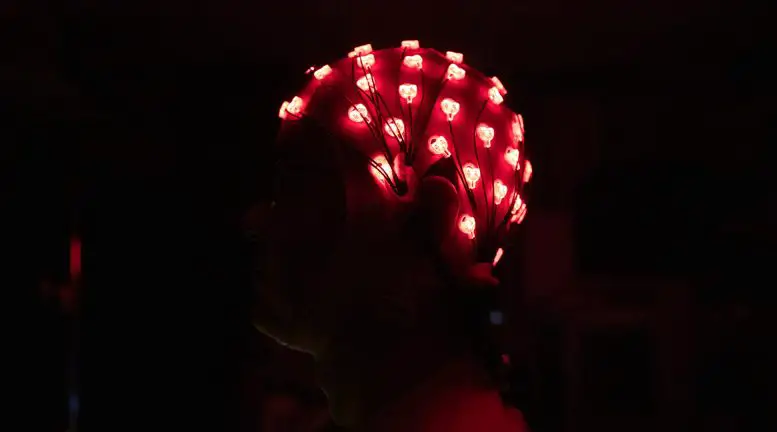
The findings, published in the journal Cerebral Cortex, will be explored as part of the Centre for Lifelong Learning and Individualised Cognition: a research collaboration between Cambridge and Nanyang Technological University (NTU), Singapore.
The neuroscientists used electroencephalography – or EEG – sensors attached to the head to measure electrical activity in the brain of 80 study participants, and sample brainwave rhythms.
The team took alpha waves readings. The mid-range of the brainwave spectrum, this wave frequency tends to dominate when we are awake and relaxed.
Alpha waves oscillate between eight to twelve hertz: a full cycle every 85-125 milliseconds. However, every person has their own peak alpha frequency within that range.
Scientists used these readings to create an optical “pulse”: a white square flickering on a dark background at the same tempo as each person’s individual alpha wave.
Participants got a 1.5-second dose of personalized pulse to set their brain working at its natural rhythm – a technique called “entrainment” – before being presented with a tricky quick-fire cognitive task: trying to identify specific shapes within a barrage of visual clutter.

A brainwave cycle consists of a peak and a trough. Some participants received pulses matching the peak of their waves, some the trough, while some got rhythms that were either random or at the wrong rate (a little faster or slower). Each participant repeated over 800 variations of the cognitive task, and the neuroscientists measured how quickly people improved.
The learning rate for those locked into the right rhythm was at least three times faster than for all the other groups. When participants returned the next day to complete another round of tasks, those who learned much faster under entrainment had maintained their higher performance level.
“It was exciting to uncover the specific conditions you need to get this impressive boost in learning,” said first author Dr. Elizabeth Michael, now at Cambridge’s Cognition and Brain Sciences Unit.
“The intervention itself is very simple, just a brief flicker on a screen, but when we hit the right frequency plus the right phase alignment, it seems to have a strong and lasting effect.”
Importantly, entrainment pulses need to chime with the trough of a brainwave. Scientists believe this is the point in a cycle when neurons are in a state of “high receptivity.”
“We feel as if we constantly attend to the world, but in fact, our brains take rapid snapshots and then our neurons communicate with each other to string the information together,” said co-author Prof Victoria Leong, from NTU and Cambridge’s Department of Paediatrics.

“Our hypothesis is that by matching information delivery to the optimal phase of a brainwave, we maximize information capture because this is when our neurons are at the height of excitability.”
Previous work from Leong’s Baby-LINC lab shows that brainwaves of mothers and babies will synchronize when they communicate. Leong believes the mechanism in this latest study is so effective because it mirrors the way we learn as infants.
“We are tapping into a mechanism that allows our brain to align to temporal stimuli in our environment, especially communicative cues like speech, gaze, and gesture that are naturally exchanged during interactions between parents and babies,” said Leong.
“When adults speak to young children they adopt child-directed speech – a slow and exaggerated form of speaking. This study suggests that child-directed speech may be a spontaneous way of rate-matching and entraining the slower brainwaves of children to support learning.”
The researchers say that, while the new study tested visual perception, these mechanisms are likely to be “domain general”: applying to a wide range of tasks and situations, including auditory learning.
They argue that potential applications for brainwave entrainment may sound like the stuff of science fiction, but are increasingly achievable. “While our study used complex EEG machines, there are now simple headband systems that allow you to gauge brain frequencies quite easily,” said Kourtzi.
“Children now do so much of their learning in front of screens. One can imagine using brainwave rhythms to enhance aspects of learning for children who struggle in regular classrooms, perhaps due to attentional deficits.”
Other early applications of brainwave entrainment to boost learning could involve training in professions where fast learning and quick decision-making is vital, such as pilots or surgeons. “Virtual reality simulations are now an effective part of training in many professions,” said Kourtzi.
“Implementing pulses that sync with brainwaves in these virtual environments could give new learners an edge, or help those retraining later in life.”
Reference: “Learning at your brain’s rhythm: individualized entrainment boosts learning for perceptual decisions” by Elizabeth Michael, Lorena Santamaria Covarrubias, Victoria Leong and Zoe Kourtzi, 9 November 2022, Cerebral Cortex.



